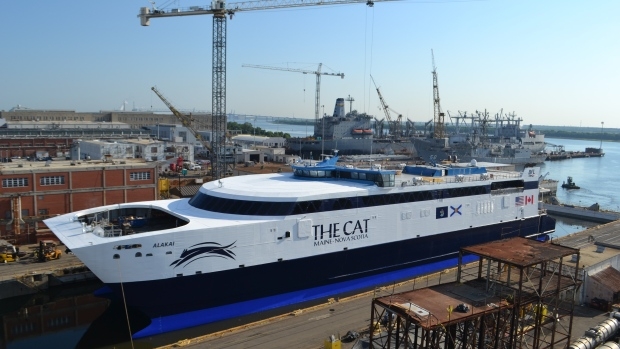Lawyers for Bay Ferries and the provincial government were in court last week arguing we should not be allowed to know how much the province is paying Bay Ferries not to operate a ferry between Yarmouth and Maine. Only in Nova Scotia, you say.

On Thursday, lawyers for the McNeil government and Bay Ferries Limited appeared before Nova Scotia Supreme Court Justice Richard Coughlan to dissect the deliberative differences between a “management fee” and a “profit margin,” and to make clear that, in either case, neither is any of our business.
The subject before the bar is a secret 10-year contract between Bay Ferries and Nova Scotia’s Department of Transportation, Infrastructure and Renewal to operate a (supposedly) tourist-generating summer ferry between Yarmouth and (some place in) Maine.
More than five years after it was signed, we still don’t know the details of that contract, but we do know we’ve been paying dearly for whatever is hidden in its pages.
My colleague, Tim Bousquet, who has tracked “publicly announced ferry expenditures” since the service began in 2015, reported on March 21, 2019, that the government had shelled out $38,887,310 during the ferry’s first three disappointing seasons while it carried an average of fewer than 42,000 visitors a summer to our shores. We, in effect, paid each of them $312 just for coming to visit.
One hundred thousand welcomes indeed!
But wait. It got worse. Last year we spent another $17.8 million to not complete renovations at a new Bar Harbor, Maine, ferry terminal, and to not carry one single passenger all season.
And then, worse again. This past summer, thanks not only to COVID-19 but also to the reality those Bar Harbor ferry terminal renovations — 20 months in the doing and still not done — were still not done, the ferry once again carried not a single passenger.
According to this year’s provincial budget, however, Nova Scotia taxpayers will be on the hook for another $16.3 million.
Surely not. Not another $16.3 million and no passengers?
Stephen McNeil, who refuses to call the House of Assembly into session while he contemplates his coming retirement, hasn’t been in the legislature since March to answer opposition questions on that or any other matter.
But, on June 26, after he announced the 2020 season had also been cancelled, reporters pressed him on just how much this year’s non-ferry service would set back taxpayers. “We have contractual obligations we’re going to have to fill,” he said obliquely. “I don’t know the exact number.”
Contractual obligations? We’ll come back to that.
But let’s circle back to for a back of the napkin cumulative calculation of the numbers to date (remembering, of course, that we’re just halfway through a 10-year contract).
By the end of this fiscal year, Nova Scotia taxpayers will have spent close to $73 million to bring an anemic average of 25,000 travellers a year to Nova Scotia. The per passenger subsidy now amounts to… oh, let’s not even go there.
Back to those contractual obligations the government and Bay Ferries say we’re not entitled to know about.
Although not every single one of those taxpayer dollars passed into or through the hands of Bay Ferries — the government directly paid out about $10 million to upgrade US terminals in Portland and Bar Harbor on Bay Ferries’ behalf and will, if the service ever resumes, be responsible for paying the salaries of US Customs and Border Patrol officers at the terminal — most of those millions will have at least touched the ferry operator’s bank account.
Some of the subsidy, of course, goes to pay for supplies and services — the cost of leasing the vessel and crewing it with Americans (as contractually required), the cost of fuel, the cost of catering services, the cost of marketing and so on — but some undisclosed chunk also goes directly to Bay Ferries (Mark MacDonald, CEO and majority shareholder) as what the government used to call a “management fee” and what Bay Ferries’ legal team now prefers we think of as a “profit margin.”
My Examiner colleague, Jennifer Henderson, who ably covered last week’s hearing, noted that “very little information was provided to the court about how Bay Ferries margins are calculated.”
But Investopedia describes profit margin as “a company’s bottom line after all other expenses, including taxes and one-off oddities, have been taken out of revenue.” Let’s go with that.
So, Bay Ferries’ revenue includes ticket sales — of which there have been precious few in the best of times and none in the last two years — plus a contracted government subsidy of about $14 million each year.
On the expense side, you have all the usual cost items, except… wait a minute. Those costs must have been dramatically reduced during the last two years, given that the ferry hasn’t made a single trip or carried a single passenger.
So, does that mean Bay Ferries’ profit margin is the net of its government subsidy minus a few pennies here and there to keep the lights on?
Surely not?
But then again, we don’t know. And neither the McNeil government nor Bay Ferries wants us to.
Henderson not only detailed last week’s legal wrangling over terminology but she also reminded us importantly of the history of how the issue ended up in the courts.
Back in December 2018, the province’s Privacy Commissioner Catherine Tully recommended the McNeil government disclose what it paid Bay Ferries to manage the service.
The McNeil government rejected the recommendation. In February of 2019, the PC caucus filed the paperwork asking for a court order to disclose the amount being paid directly to Bay Ferries.
The government’s and Bay Ferry’s legal arguments — regardless of how we describe the actual amount paid to Bay Ferries — revolve around the notion that such information is “commercially sensitive.”
Bay Ferries claimed that knowing how it calculated its profit margin would give competitors an advantage when — if, one hopes — the contract comes up for renewal.
“In the hands of a knowledgeable competitor,” the company’s lawyer, Scott Campbell, told the judge, “this information would provide considerable insight to that company on how Bay Ferries structures its affairs and submits bids to the procurement process.”
In his own testimony, wrote Henderson, Bay Ferries CEO Mark MacDonald seemed to suggest that if his suppliers knew how much he was making out of the deal, “the cost of fuel, catering services, and other commodities could become more expensive, not just for Bay Ferries but the taxpayer footing the final bill.”
The government’s lawyers hopped on that “commercially sensitive” bandwagon, adding that disclosing what the government is paying out to Bay Ferries “may send a message to other companies that the province could release their confidential business information, dissuading them from doing business with the province. If businesses are not willing to do business with the province because of the risk of disclosure of their commercially sensitive information, it will result in a less competitive environment, which. in turn, will likely drive costs higher for the province.”
So, taxpayers should be prepared to shell out more than $70 million without knowing how that money is being divvied up so the government can spend countless millions more in future secret deals it also won’t have to disclose.
Seems par for the Nova Scotia course.
The hearing is expected to wrap up on Thursday, November 19.
A version of this column originally appeared in the Halifax Examiner.
To read the latest column, please subscribe.







 STEPHEN KIMBER, a Professor of Journalism at the University of King's College in Halifax and co-founder of its MFA in Creative Nonfiction Program, is an award-winning writer, editor and broadcaster. He is the author of two novels and eight non-fiction books. Buy his books
STEPHEN KIMBER, a Professor of Journalism at the University of King's College in Halifax and co-founder of its MFA in Creative Nonfiction Program, is an award-winning writer, editor and broadcaster. He is the author of two novels and eight non-fiction books. Buy his books